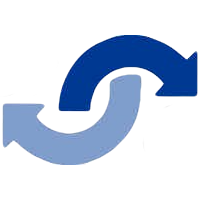Checking in with your teams is really about starting from a place of authenticity, genuine care and compassion.
As many companies feel the uncertainty of the world and how their teams are doing, it is so important to take the time to check in with your teams to determine how they are coping, what they need, and how you can support. The worst thing we can do as leadership is to make assumption.
One employees' paradise is another employees' battleground.
After months of supporting our clients and teams both onsite and remotely, we worked together to come up with 5 tips on how to effectively check in with your teams:
1. Be proactive
When approaching your employees, the number one thing we would tell you, is that employees feel most supported when they don’t need the help, but know it’s available if and when they do.
This means that you don't wait for the forest to burn down, you reach out before the kindle even begins.
This holds true for everyone on the team; from your internal and external teams, remote and onsite, and the most junior employees right through to c-suite. This is the time to make everyone feel cared for and supported; contractors and employees alike.
The more you bring people together, the stronger your team will be.
2. Go beyond health & safety
With COVID creating a new reality, we are often focused on the health and safety of the teams. Career Contacts has been supporting a number of clients with ensuring that they are keeping their teams safe. Working with WorkSafeBC guidelines, we are supporting training, policies and practices, and constantly performing audits and encouraging dialogue. We are putting up signs, barriers, sanitizer and creating space for employees to feel safe while at work.
We value the health and safety of all employees but know that this goes far beyond COVID.
Through COVID, we have had discussions around:
- Mental Health
- Child and other dependent support
- Ability and access to working from home
- Burnout
- Commute
- Socialization
- Building community
- and on and on
For example, at the beginning of COVID, construction companies continued to do the work; learning as they went with the new COVID safety guidelines.
Career Contacts has had the opportunity of supporting in a number of ways to ensure that our temporary staff were feeling safe. At the beginning of each assignment, a member of our team would go onsite to check in and make sure the teams felt comfortable to raise any concerns. We also provided them with our personal numbers so they could text us throughout the day if they need to. What it felt like we were doing was ensuring social distancing, mask wearing and hand washing. What we were really doing was making ourselves available; valuing their needs over our time and providing them with assurances that we cared (because we genuinely did, and do).
3. Flexibility
Did you know that when discussing the benefits and perks of joining organizations, even above the ability to work from home, salary, benefits and vacation, is flexibility?
What does that me to us?
That people want to be treated with respect, and trust. They are adults, who have been given a list of roles and responsibilities, and want to be able to have some flexibility on how they execute against instructions.
It’s not just about the flexibility of working hours, but also in how they structure the day, how they manage their calendars, what technology they can add to create value, what process they use to reach their goals and targets etc.
4. Get out of the office/zoom
Moving employees away from their regular “office” environment, allows them to shift out of work mode, and know that the conversation is about them as people first, employees second.
We often encourage conversations that are lighter, that may even just be an opportunity to make genuine connections and build meaningful relationships that do not place all the value on what they do within the organization. If you have an office space that can be used, that’s a great way to connect physically. If not, meeting outside for a distanced walk, or even hoping on a different social platform so there is a different feel.
5. Be open yourself
As part of the leadership team, I am comfortable talking about my struggles, my insecurities, as much as I am talking about my goals and dreams. Not everything has to be about what isn’t working; sometimes it’s just about sharing where you want to see things moving, and ensuring that you are supporting that journey the best way you can.
We recently had a senior level executive assistant that was working with a client of ours for 20+ years who was facing a career dilemma. During COVID, she had a realization that she had been able to spend more time with her hobbies and creative outlets; one of which was writing.
After some discussion, we were able to approach the marketing department where she now works, and create a hybrid opportunity for her to create some news letter content that allowed her to flex her creative muscles, while still being able to continue to stay gainfully employed with her existing team.
The moral of this blog? Treat your people are whole people. Learn about what makes them happy at work, what they need to feel fulfilled, how they like to be appreciated, communicated with etc. Then, take the time to make a meaningful change in the way you work together!
Looking for some support in building out your communication and employee relations plans? Reach out to us at Career Contacts and one of our HR Consultants would be happy to provide you with an overall audit and ideation session.

